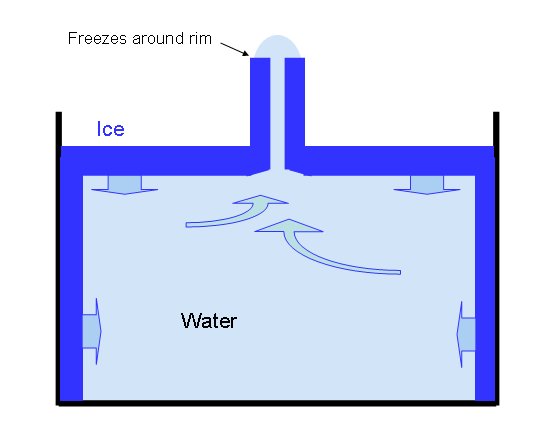Ice
Spikes
Water in ice cube containers start to freeze on the top, then the edges. Usually, there's a small hole unfrozen on the top, as the edges start to freeze. The ice expands, pouring out through the small hole, creating a hill with each expansion. The water freezes from the bottom up, allowing the spike to grow. The best results come from distilled water because of the little/low concentration of salt in the water. Ordinary tap water contains mineral salts, which easily kills the ice spikes. Although this is true, there are rare occasions that allow tap water to form ice spikes. There are more details in perfecting the environment in order to create the perfect ice spikes, taking into consideration the temperature and such, (Kenneth, Ice Spikes). Visit SnowCrystals.com to view more details about ice spikes.
photo taken
from Ice Spikes
Do
you ever look into your freezer to find your ice has grown a single
spike in the middle of the ice cube? The spikes are known as ice
spikes. This is because of the way the water freezes. In
order for ice spikes to form, it's best to use distilled water.
photo taken
from Ice Spikes
Water in ice cube containers start to freeze on the top, then the edges. Usually, there's a small hole unfrozen on the top, as the edges start to freeze. The ice expands, pouring out through the small hole, creating a hill with each expansion. The water freezes from the bottom up, allowing the spike to grow. The best results come from distilled water because of the little/low concentration of salt in the water. Ordinary tap water contains mineral salts, which easily kills the ice spikes. Although this is true, there are rare occasions that allow tap water to form ice spikes. There are more details in perfecting the environment in order to create the perfect ice spikes, taking into consideration the temperature and such, (Kenneth, Ice Spikes). Visit SnowCrystals.com to view more details about ice spikes.
Frost
Flowers/Ice
Ribbons/ Ice Flowers
This is actually pretty neat. From a distance, ice ribbons on the ground may look like "dropped tissues," (Carter, Ice). To visualize the ribbon-like ice and to see the history of sighting and documenting theories of their formation, you can visit Dr. James Carter's website, explaining his (and others') findings of ice in this nature. You'll notice that the ice is very curved and twisted. The photographs Dr. Carter provides are actually of small ice ribbons. Notice the surrounding leaves; this gives you a reference to the size of the ice.
These frost flowers have been also called frostweeds and have been declared a result of botanical reasons. There are many theories of the cause of this formation. One theory was that it comes from the sap of a plant that is crystalized. The amount of the sap needed in order to create the amount of ice that grows around the twigs is much more than it should be able to hold, eliminating the sap theory. As the formation of the frost flowers were observed, it was shown that the moisture from the soil moved to the dry stems. The water seeps into the creaks of the stem and starts its formation there.
Dr. Carter states, "In summary, we know the formation of frost flowers, ice flowers or ice ribbons is a physical process, not related to the growth of a biological organism. These ice formations occur on probably only on the dead stems of a few species of plants and on certain pieces of rotten wood on the ground.... These form when the water in the soil remains above freezing while the air temperature falls below freezing. The conditions would be optimal on clear nights with no wind, when the dominand cooling process is net radiation," (Carter, Ice).
This is actually pretty neat. From a distance, ice ribbons on the ground may look like "dropped tissues," (Carter, Ice). To visualize the ribbon-like ice and to see the history of sighting and documenting theories of their formation, you can visit Dr. James Carter's website, explaining his (and others') findings of ice in this nature. You'll notice that the ice is very curved and twisted. The photographs Dr. Carter provides are actually of small ice ribbons. Notice the surrounding leaves; this gives you a reference to the size of the ice.
These frost flowers have been also called frostweeds and have been declared a result of botanical reasons. There are many theories of the cause of this formation. One theory was that it comes from the sap of a plant that is crystalized. The amount of the sap needed in order to create the amount of ice that grows around the twigs is much more than it should be able to hold, eliminating the sap theory. As the formation of the frost flowers were observed, it was shown that the moisture from the soil moved to the dry stems. The water seeps into the creaks of the stem and starts its formation there.
Dr. Carter states, "In summary, we know the formation of frost flowers, ice flowers or ice ribbons is a physical process, not related to the growth of a biological organism. These ice formations occur on probably only on the dead stems of a few species of plants and on certain pieces of rotten wood on the ground.... These form when the water in the soil remains above freezing while the air temperature falls below freezing. The conditions would be optimal on clear nights with no wind, when the dominand cooling process is net radiation," (Carter, Ice).
Contents:

